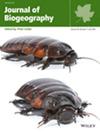The Role of Migration in the Change of Northern Hemisphere Vegetation for the Past 50,000 Years
Abstract
Aim
Our primary aim was to assess how dispersal limitation affected forest changes in the Northern Hemisphere during the last glacial cycle, and especially after the last deglaciation.
Location
Northern Hemisphere (between 20°N and 80°N).
Time Period
50,000–0 years before present.
Major Taxa Studied
Angiosperms and gymnosperms.
Methods
We used the LPJ-GM 2.0 dynamic global vegetation model to simulate the vegetation dynamics of the Northern Hemisphere over the past 50,000 years. We compared two dispersal modes by allowing establishment as soon as suitable environmental conditions were realised (free dispersal), or by additionally constraining establishment based on potential migration speed and maturation time (dispersal limitation). For both dispersal modes, we inferred (mega-)biomes and calculated the fraction of forest cover, earliest post-glacial forest establishment, and the difference between dispersal modes (dispersal lag). To evaluate our results, we compared simulated tree cover with pollen-based reconstructions of European Holocene vegetation and of North American vegetation since the Last Glacial Maximum.
Results
We simulated multi-millennial dispersal lags in post-glacial establishment of temperate forests in Europe, boreal forests in Central Siberia, and scattered forest areas close to mountain chains (Rocky Mountains and north of Himalaya). Overall, the simulation with limited dispersal had lower forest extents compared to the free-dispersal simulation, especially after the Last Glacial Maximum, with greater mismatches following intervals of rapid warming, notably the onsets of GI-1 and the Holocene. Comparisons with pollen reconstructions showed that the simulation with limited dispersal better captured both the expansion of European temperate trees and the distribution of broadleaved and needleleaved trees in North America during the early Holocene.
Main Conclusions
The lag in response of forests to rapid climate change has implications for past ecosystems and projections of future ecosystem services.


 求助内容:
求助内容: 应助结果提醒方式:
应助结果提醒方式:


